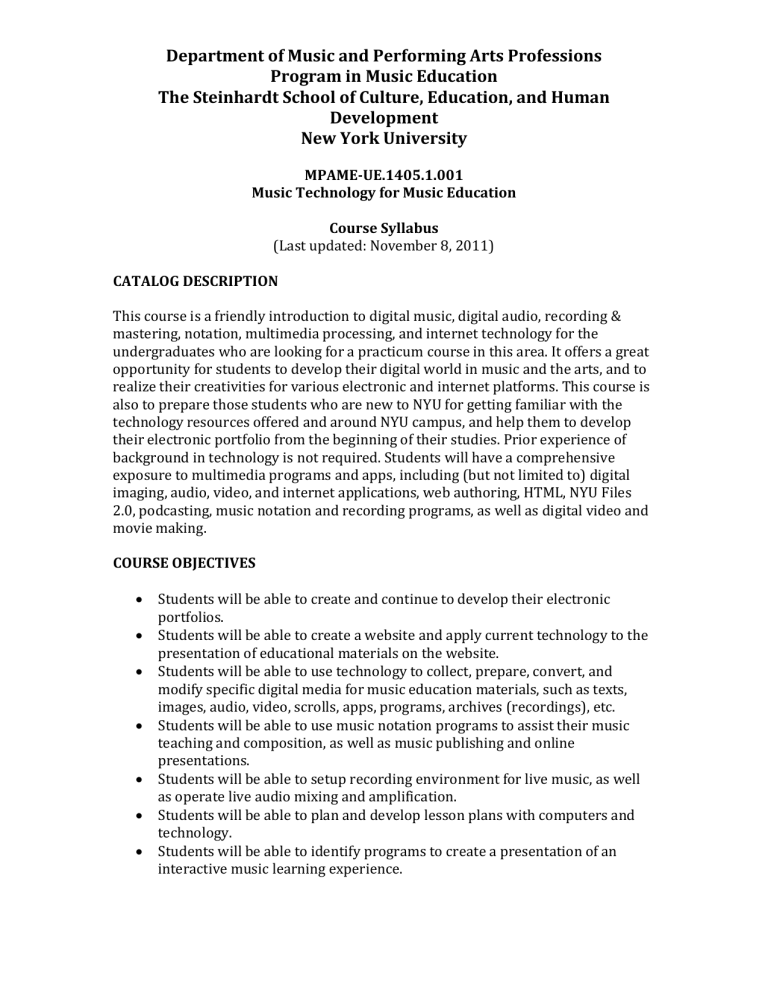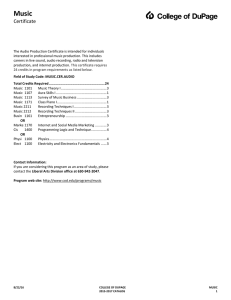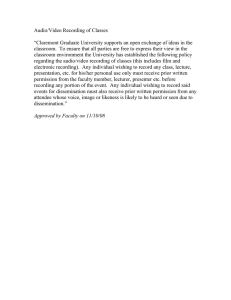MPAME-UE 1405

Department of Music and Performing Arts Professions
Program in Music Education
The Steinhardt School of Culture, Education, and Human
Development
New York University
MPAME-UE.1405.1.001
Music Technology for Music Education
Course Syllabus
(Last updated: November 8, 2011)
CATALOG DESCRIPTION
This course is a friendly introduction to digital music, digital audio, recording & mastering, notation, multimedia processing, and internet technology for the undergraduates who are looking for a practicum course in this area. It offers a great opportunity for students to develop their digital world in music and the arts, and to realize their creativities for various electronic and internet platforms. This course is also to prepare those students who are new to NYU for getting familiar with the technology resources offered and around NYU campus, and help them to develop their electronic portfolio from the beginning of their studies. Prior experience of background in technology is not required. Students will have a comprehensive exposure to multimedia programs and apps, including (but not limited to) digital imaging, audio, video, and internet applications, web authoring, HTML, NYU Files
2.0, podcasting, music notation and recording programs, as well as digital video and movie making.
COURSE OBJECTIVES
Students will be able to create and continue to develop their electronic portfolios.
Students will be able to create a website and apply current technology to the presentation of educational materials on the website.
Students will be able to use technology to collect, prepare, convert, and modify specific digital media for music education materials, such as texts, images, audio, video, scrolls, apps, programs, archives (recordings), etc.
Students will be able to use music notation programs to assist their music teaching and composition, as well as music publishing and online presentations.
Students will be able to setup recording environment for live music, as well as operate live audio mixing and amplification.
Students will be able to plan and develop lesson plans with computers and technology.
Students will be able to identify programs to create a presentation of an interactive music learning experience.
MPAME-UE.1405.1.001 Course Syllabus
Department of Music and Performing Arts Professions
Page 2
REQUIRED TEXT OR SOURCE MATERIALS
There is no required book for this course. Readings and assignments will be provided to students via internet on Blackboard. Students will also be expected to source – and share with their classmates – much of their own reading material and findings from periodicals and internet resources.
COURSE CONTENTS
Week 1
Course Introduction
NYU Home & Blackboard
NYU Files 2.0 Server and initial activation
Website Establishment (NYU Files 2.0)
Web Hosting Servers (NYU ITS)
Software and Applications (WWW Authoring and Music
Teaching/Technology tools)
Internet, WWW, and Computers for Music Education
Technology Facilities and Resources on NYU Campus
Week 2
Understanding Files and Folders, and Web Hosting Server Database
Structure
Accessing Web Hosting Server: File Transfer Protocol
Accessing Web Content through Browsers: Hyper-Text Transfer Protocol
HTML and Simple Text Editors
HTML I o Basic HTML Syntax o Tags and Attributes I o Making Links as Anchor
Internal Links
External Links
Email Links o Basic Page Formatting o Posting Images and Embedding Audios
Week 3
HTML II o Tags and Attributes II o Building up Websites (Multiple Pages) o Web Colors and Hexadecimal System o Create Pages and Internal Links
Week 4
Digital Imaging I
MPAME-UE.1405.1.001 Course Syllabus
Department of Music and Performing Arts Professions
Page 3 o Understanding Digital Imaging and Formats o Digital Imaging Editing Programs o Pixels, Resolutions, and Resizing o Colors, Color Table, Color Mode, Levels, Basic Adjustments o Filters o Online Web-based Image Editing Sites and Resources
Week 5
Digital Audio I o Understanding Popular Digital Audio File Formats (AIFF, WAV, AU,
MP3, M4A, AAC, etc.) o Understanding Sampling Frequency and Bit-Rate o Extracting Digital Audio Files from Music/Audio CD o Converting Digital Audio Files o Posting Digital Audio on Web Pages. o Introduction to Audacity
Control Toolbar
Mixer Toolbar
Meter Toolbar
Edit Toolbar
Basic Editing (Cut, Copy, Delete, Mute, Paste, etc.)
Basic Sound Effects (Fade-In/Out, Normalize, etc.)
Week 6
Movie Authoring I o Introduction to iMovie o Ken Burns Effect, Fitting, and Cropping o Movie Clips Sequencing and Editing o Video Effects and Transitions o Text, Title, End-Credits, and Themes o Adding Audio and Music to the Movie o Exporting (Sharing) Movies o Popular Movie File Formats and Web Posting
Week 7
Movie Authoring II o Introduction to Windows Movie Maker o Media Components Collection and Preparation for Movie Making o Movie Clips Sequencing and Editing o Video Effects and Transitions o Text, Title, End-Credits, and Themes o Adding Audio and Music to the Movie o Exporting (Sharing) Movies o Popular Movie File Formats and Web Posting o Internet Video Downloading and Video File Converting
MPAME-UE.1405.1.001 Course Syllabus
Department of Music and Performing Arts Professions
Page 4 o PodCasting and Its Application for Music Education
Week 8
Digital Audio II o Detailed Audacity Operation
Track Pop-Down Menu
Split Stereo Tracks
Audio Spatial Arrangement
New Audio Tracks
Generate Tones and Silence
Advance Digital Sound Effects
Mixed Down to Stereo
Exporting Sound Files o Desktop Recording Techniques
Desktop Recording Programs
Audacity Recording from Stereo Out/Mix
Audacity Recording from Line-In
Screen Shot (Desktop Visual Recording Techniques)
Music Concrete Project o Music Concrete Background and History o Collecting Source Audio o Modifying and Treating Audio o Multi-Track Audio/Music Composition
Week 9
Notation o Introduction to Music Notation Programs o Notation Program Setup and Inputting Notes o Music Score Editing o Music Score Printing and Exporting for Different Media and
Resolutions o Music Notation Web Presentation for Music Education
Week 10
Recording Technology o Understanding Music Technology Terminology o Understanding Microphones, Cables, Mixing Boards, Recording Media and Devices, Digital Hard-Drive Recording, Audacity Recording, etc. o Basic Microphone Setup and Arrangement Techniques for Voices and
Musical Instruments o Digital Recording Mastering and Sharing
Week 11
GIF Animation o Introduction to GIF Animation Programs
MPAME-UE.1405.1.001 Course Syllabus
Department of Music and Performing Arts Professions
Page 5 o Indexing Color and Color Table o Animation and Transparency o Inter-Frame Delay and Looping for Timing Control o Transitions
Adobe Photoshop for GIF Animation and Beyond o Adobe Photoshop for Creating GIF Animation o Color Modes o Layers o Output for Web and Devices
Online GIF Animators and Resources
Week 12
Basic Web Design Concept and Philosophy o Tables and Layers o CSS and PHP o Themes, Colors, Styles, and Their Implications o Website Navigation o Music and Multimedia Presentation on the Web
Introduction to Important Web Authoring Tools and Applications o Adobe Dreamweaver o Adobe Flash
Week 13
Introduction to MIDI Sequencing Programs
Introduction to Virtual Digital Recording Studios
Introduction to Multimedia Live Performance & Controlling Programs
Introduction to Mobile Technology and Applications o iPhone (Smart Phone) and Apps in Learning Technology o iPad (Tablet) and Apps in Learning Technology o Distributing Computing Technology and Environment and Its Impacts on Music Education o Introduction to Network Learning Technology and Its Applications to
Music Education
Week 14
Electronic Portfolio
Discussion and Review o Proposal of the Final Projects o Comments and Suggestions o Debugging o Q&As o Open Discussion
Week 15
Final Project Presentation
MPAME-UE.1405.1.001 Course Syllabus
Department of Music and Performing Arts Professions
Page 6
All Course Works and Assignment Due
ASSIGNMENTS AND ASSESSMENT
Each week will assign task-specific exercises based on the contents distributed in the class.
A final project and presentation
Q&A in the form of email to expect students to research and answer
Students will be evaluated on: o weekly assignments: 40% o attendance, class participation in questions and discussions: 40% o final project and presentation (including e-mail questions and replies): 20% o All assignments must be posted on the website and/or NYU
Blackboard.
BIBLIOGRAPHY
Alten, Stanley R. Audio In Media. Fourth Ed. Belmont, California: Wadsworth
Publishing Company, 1994.
Ambardar, Ashok. Analog and Digital Signal Processing. Boston: PWS Publishing
Company, 1995.
Armstrong, Carmen L. Designing Assessment In Art. Reston, Va.: National Art
Education Association, 1994.
Aronoff, Frances Webber. Music and Young Children. Turning Wheel Press, NY.
1979.
Assayag, Gérard, Camilo Rueda, Mikael Laurson, Carlos Agon, and Olivier Delerue.
“Computer-Assisted Composition at IRCAM: From PatchWork to OpenMusic.”
Computer Music Journal. 23.3 (1999): 59-72.
Atkinson, R. C. Computer Assisted Instruction. 1969. - X-31-016131-1
Austin, Larry, and Rodney Waschka II. “Computer Music for Compact Disc:
Composition, Production, Audience.” Computer Music Journal. 20.2 (1996):
17-27.
Avital, Samuel. Mime and Beyond: The Silent Outcry. Studio City, CA: Players Press,
1990.
MPAME-UE.1405.1.001 Course Syllabus
Department of Music and Performing Arts Professions
Page 7
Bailey, Nick, and David Cooper. “Perceptually Smooth Timbral Guides by State-Space
Analysis of Phase-Vocoder Parameters.” Computer Music Journal. 24.1
(2000): 32-42.
Balaban, Mira. “The Music Structures Approach to Knowledge Representation for
Music Processing.” Computer Music Journal. 20.2 (1996): 96-111.
Bamberger, Jeanne. The Mind Behind the Musical Ear: How Children Develop
Musical Intelligence. Cambridge, MA: Harvard University Press, 1995.
Barrett, Natacha. “Little Animals: Compositional Structuring Processes.” Computer
Music Journal. 23.2 (1999): 11-18.
Bates, A. W. “Computer assisted learning or communications : which way for information technology in distance education?” Milton Keynes : Open
University IET, 1986. - (IET paper on broadcasting ; no.250). - x-31-108466-3
Beethoven, J. The Music Connection. Morristown, NJ: Silver Burdette Ginn. 1995.
Begault, Durand R. 3D Sound. For Virtual Reality and Multimedia. Cambridge:
Academic Press, 1994.
Bell G. “Project Zero: Nelson Goodman's Legacy In Arts Education.” J AESTHET ART
CRITIC 58 (3): 245-249 SUM, 2000.
Benade, Arthur H. Fundamentals of Music Acoustics. Second, Revised Ed. New York:
Dover Publications, 1990.
Bergethon, B., Boardman, E. & Montgomery, J. Musical Growth in the Elementary
School. New York: Harcourt Brace. 1986.
Besenjak, Cheryl. Copyright Plain and Simple Second Ed. Career Press, Inc. 2000.
Blandford, A. “Design, Decisions And Dialogue.” n.p., 1991. Thesis (Ph.D.)-Open
University. Author no.M7033956. BLDSC no.DX95809. - x-31-114667-7
Bond, J. Share the Music. New York: MacMillan/McGraw-Hill School Publishing.
1995
Bowers, Michael. Pro CSS and HTML Design Patters. Berkeley, CA: Apress 2007.
Braut, Christian. The Musician's Guide to MIDI. Alameda, CA: Sybex, 1994.
Bray, David: “CD-ROM in Music Education.” British Journal of Music Education 14:2 p.137-142. July, 1997.
MPAME-UE.1405.1.001 Course Syllabus
Department of Music and Performing Arts Professions
Page 8
Bruner, Jerome. Actual Minds, Possible Worlds. Cambridge, MA: Harvard University
Press, 1986.
Burton, Anthony R, and Tanya Vladimirova. “Generation of Musical Sequences with
Genetic Techniques.” Computer Music Journal. 23.4 (1999): 59-73.
Campbell, P.S., Brabson, E.M. & Tucker, J. Roots And Branches: A Legacy Of
Multicultural Music For Children. Danbury, CT: World Music Press. 1994.
Camurri., Antonio, Shuji Hashimoto, Matteo Ricchetti, Andrea Ricci, Kenji Suzuki,
Riccardo Trocca, and Gualtiero Volpe. “EyesWeb: Toward Gesture and Affect
Recognition in Interactive Dance and Music Systems.” Computer Music
Journal. 24.1 (2000): 57-69.
Castro, Elizabeth. Visual Quickstart Guide: HTML, XHTML & CSS Sixth Ed. Berkeley,
CA: Peachpit Press, 2007.
Cemgil, Ali Taylan, Peter Desain, and Bert Kappen. “Rhythm Quantization for
Transcription.” Computer Music Journal. 24.2 (2000): 60-76.
Cogan, Robert and Pozzi Escot. Sonic Design: The Nature of Sound and Music.
Englewood Cliffs, NJ: Prentice-Hall, 1976.
Cook, Wayne D. Center Stage: A Curriculum for the Performing Arts. 2 vols.: K-3, 4-6.
Palo Alto, CA: Seymour, 1993.
Cope, David. Techniques of the Contemporary Composers. New York: Schirmer
Books, 1997.
Csikszentmihalyi, Mihaly. Changing the World: A Framework for the Study of
Creativity. Westport, CT: Praeger, 1994.
Dannenberg, Roger B. “A Perspective on Computer Music.” Computer Music Journal.
20.1 (1996): 52-56.
Davis, Don, and Carolyn Davis. Sound System Engineering. Second Ed. Boston: Focal
Press, 1997.
De Poli, Giovanni. “In Search of New Sounds.” Computer Music Journal. 20.2 (1996):
39-43.
DeLong, Patrick D. Art And Music In The Humanities. Englewood Cliffs, N.J., Prentice-
Hall. 1966.
Deutsch, Diana. Ed. The Psychology of Music. Second Ed. London: Academic Press,
1999.
MPAME-UE.1405.1.001 Course Syllabus
Department of Music and Performing Arts Professions
Page 9
Dickreiter, Michael. Tonmeister Technology. Recording Environments, Sound
Sources and Microphone Techniques. New York: Temmer Enterprises, 1989.
Dixon, Steve. Digital Performance: A History of New Media in Theatre, Dance,
Performance Art, and Installation. Cambridge, MA: MIT Press, 2007.
Dodge, Charles and Thomas A. Jerse. Computer Music, Synthesis, Composition, and
Performance. New York: Schirmer Books, 1985.
Dooling, Robert J. and Stewart H. Hulse. Ed. The Comparative Psychology of
Audition: Perceiving Complex Sounds. Hillsdale: Lawrence Erlbaum
Associates, Publishers, 1989.
Eisner, Elliot W. Educating Artistic Vision. New York, Macmillan. 1972.
Ferrara, Lawrence. Philosophy and the Analysis of Music, Bridges to Musical Sound,
Form, and Reference. New York: Greenwood Press, 1991.
Fishman, Stephen. The Public Domain: How to Find and Use Copyright-Free
Writings, Music, Art and More. Nolo.com. 2001.
Hofstetter, Fred T. Computer Literacy for Musicians. Englewood Cliffs NJ: Prentice
Hall, 1988.
Keiner, Lenore. The Creative Classroom. Westport, CT: Heinemann, 1993.
Kendall, Gary S. "A 3-D Sound Primer: Directional Hearing and Stereo
Reproduction." Computer Music Journal. 19.4 (1995): 23-46.
Kientzle, Tim. A Programmer's Guide to Sound. Reading, MA: Addison Wesley
Longman, 1998.
Kimberlin, Cynthia Tse and Akin Euba, Ed. Intercultural Music Volume 1. Bayreuth,
1995.
Kostka, Stefan. Materials and Techniques of Twentieth-Century Music. Second Ed.
Englewood Cliff, NJ: Prentice-Hall, 1999.
Lesbros, Vincent. “From Image to Sounds, A Dual Representation.” Computer Music
Journal. 20.3 (1996): 59-69.
Lyons, Ian. Computer Darkroom. Oct. 2000.
<http://www.btinternet.com/~ian.lyons/>.
MPAME-UE.1405.1.001 Course Syllabus
Department of Music and Performing Arts Professions
Page 10
Mark, M. L. A History Of American Music Education. New York: Schirmer Books.
1992.
---. Contemporary Music Education. (Second Ed.). New York: Schirmer Books. 1986.
---. Source Readings In Music Education History. New York: Schirmer Books. 1982.
Marmour, E. & Solie, R.A. (Eds.). Explorations In Music, The Arts, And Ideas: Essays
In Honor Of Leonard B. Meyer. Stuyvesant, NY: Pendragon Press. 1988.
McClelland, Deke, and Katrin Eismann. Digital Photography. Industrial-Strength
Techniques. Berkeley: Peachpit Press, 1999.
McNeil, Patrick. The Web Designer’s Idea Book Vol 1 & 2. Cincinnati, Ohio: How
Books, 2010.
Mialaret, G. The Psychology of the Use of Audio-Visual Aids in Primary Education.
New York: Unesco Publications Center, 1966.
Moore, F. Richard. Elements of Computer Music. Englewood Cliffs, NJ: Prenticall-
Hall, 1990.
---. “Dreams of Computer Music -- Then and Now.” Computer Music Journal. 20.1
(1996): 25-41.
Muffoletto, R. and Knupfer, N.N. (Eds). Computers in Education: Social, Political, and
Historical Perspectives. Cresskill, NJ: Hampton Press. 1995.
National Art Education Association. Art Education: Content And Practice In A
Postmodern Era. Reston, Va. : National Art Education Association, 1997.
National Education Association, Office of Higher Education Information Technology:
A Road to the Future. Washington, DC: National Education Association. 2001.
Negrino, Tom and Dori Smith. Visual Quickstart Guide: Dreamweaver CS5. Berkeley,
CA: Peachpit Press, 2010.
Papert, S. Mindstorms: Children, Computers, And Powerful Ideas. New York: Basic
Books. 1980.
Polsky, Milton. Let’s Improvise! New York: Applause, 1998.
Roads, Curtis. Ed. The Music Machine. Cambridge: The MIT Press, 1989.
Robbins, Jennifer Niederst. Learning Web Design – A Beginner’s Guild to (x)html,
Style Sheets, and Web Graphics. Sebastopol, CA: O’Reilly Media Inc., 2007
MPAME-UE.1405.1.001 Course Syllabus
Department of Music and Performing Arts Professions
Page 11
Rossing, Thomas D. The Science of Sound. Second Ed. New York: Addison-Wesley
Publishing Company, 1990.
Rubin, David M. The Desktop Musician. Berkeley, California: Osborne McGraw-Hill,
1995.
Rudolph, Thomas E. Teaching Music With Technology. GIA Publications, Inc.
Chicago, IL. 1996.
Scheirer, Eric D., and Barry L. Vercoe. "SAOL: The MPEG-4 Structured Audio
Orchestra Language." Computer Music Journal. 23.2 (1999): 31-51.
Serafine, M. L. Music As Cognition: The Development Of Thought In Sound. New
York: Columbia University Press. 1987.
Sluchin, Benny. “A Computer-Assisted Version of Stockhausen's Solo for a Melody
Instrument with Feedback.” Computer Music Journal. 24.2 (2000): 39-46.
Toiviainen, Petri. “An Interactive MIDI Accompanist.” Computer Music Journal. 22.4
(1998): 63-75.
Van Duyne, Kouglas, James A. Landay, and Jason I. Hong. The Design of Sites:
Patterns for Creating Winning Web sites Second Edition. Englewood Cliffs NJ:
Prentice Hall, 2007.
Vantomme, Jason D. “Score Following by Temporal Pattern.” Computer Music
Journal. 19.3 (1995): 50-59.
Ullman Larry. Visual Quickstart Guide: PHP for the World Wide Web Second Edition.
Berkeley, CA: Peachpit Press, 2004.
Ulrich, Katherine. Visual Quickstart Guide: Flash Professional CS5. Berkeley, CA:
Peachpit Press, 2011.
U.S. Congress, Office of Technology Assessment. Teachers and Technology: Making the Connection, OTA-EHR-616, Washington, DC: U.S. Government Printing
Office. (April, 1995).
Walls, Kimberly C. “Music Performance and Learning: The Impact of Digital
Technology.” Psychomusicology - A Journal of Research in Music Cognition
:16 p.68-76. Spring-Fall, 1997.
Watkinson, John. The Art of Digital Audio. Second Ed. Boston: Focal Press, 1994.
MPAME-UE.1405.1.001 Course Syllabus
Department of Music and Performing Arts Professions
Page 12
William, David Brian and Peter Richard Webster. Experiencing Music Technology:
Software, Data and Hardware. Second Ed. New York: Schirmer Books, 1999.
Woolman, Matt. Sonic Graphics: Seeing Sound. Washington, DC: Rizzoli, 2000.
Wöhrmann, Rolf, and Guillaume Ballet. “Design and Architecture of Distributed
Sound Processing and Database Systems for Web-Based Computer Music
Applications.” Computer Music Journal. 23.3 (1999): 73-84.



